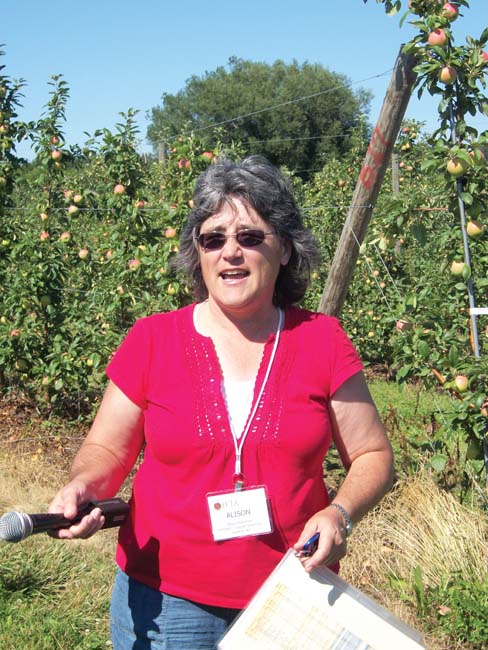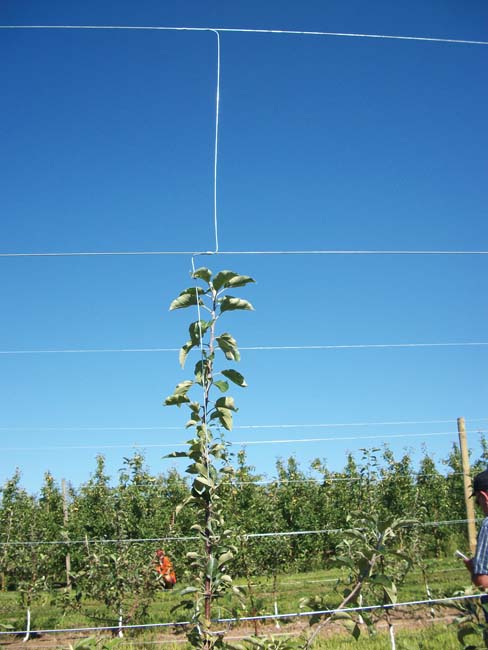Tom DeMarree bought this Blosi platform and uses it for many tasks, including installing trellis wire.

Workers crimp stabilizer wires onto trellis wires. The stabilizer wires eliminate the need for additional stakes
or posts.
Two years ago, the Lake Ontario Fruit Program, with a Northeast Risk Management grant and funds from Cornell Cooperative Extension, organized a trip for western New York growers to see the orchards of Mo and Andre Tougas in Massachusetts. There, Tom DeMarree saw an Italian-made, self-propelled platform, the N. Blosi Zip 25.
The Tougases were using it to pick apples too high up for pick-your-own customers (they don’t let customers use ladders) and to prune and train young trees and hand-thin peaches. DeMarree decided to import a machine for himself.
Now, he finds, this machine, which cost just under $50,000, along with a locally built platform on a bin trailer, serves his needs for his high-density apple and peach plantings. The platforms are used in 106 acres of peaches on V systems (16- to 18-foot rows) and apples on tall spindle and vertical axis systems (12- to 14-foot rows).“I’m satisfied with the cost and what it’s done for me,” he said.
His crew uses the machine for pruning, training trees, installing trellis, and hand thinning. For pruning in winter, he uses a small snow blower to clean out a narrow path so the platform can move between the tree rows if the snow gets too deep. He has not yet used it for harvesting, preferring his bin trailer system serving a crew of pickers.
The Blosi platform is self-propelled with variable-speed drive and automatic steering and automatic leveling up to 10 degrees. The platform moves in and out from 5.5 to 11 feet as well as up and down, easily reaching tops of the 11-foot trees. A worker on the platform operates the controls, but steering is automatic, controlled by a rod that “feels” the trees.
Last summer, DeMarree showed visitors on an International Fruit Tree Association tour to his farm how the machine works for installing trellis.
Like many New Yorkers, he uses the tall spindle system, planting trees on a 3- by 12-foot spacing. Trellis wires are mounted on 12-foot posts driven into the ground 2.5 feet. He uses four 12-gauge wires, with the bottom wire there to stabilize young trees. It will later be removed so workers can pick more easily, stepping between the trees.
Instead of stakes made of bamboo or conduit, the New Yorkers use 12-gauge stabilizer wires six to eight feet long. In installing them, workers on the platform first crimp to the top wire, the fourth wire. Then they bend it and crimp it again to the next wire down, the third wire. A worker on the ground crimps it to the second wire.
Crimps are made using air-powered guns, and the air compressor is built into the Blosi. Metal clips are attached to the horizontal wires and around the trees.
DeMarree plants modern, high-value varieties like Honeycrisp using Budagovsky 9 rootstocks to gain some resistance to fireblight, which is a huge problem in his area.
“I fight fireblight constantly,” he said, “I would like a little higher vigor tree. I give up a year’s growth because of fireblight. I plan to shift to a higher vigor Geneva rootstock in the future.”
Geneva rootstocks are resistant to fireblight, but that does not impart resistance to the scion. It assures, however, that strikes will not kill the tree to the root.
Tom is married to Alison DeMarree, who is the economist member of the Lake Ontario Fruit Program, a four-person extension team serving western New York growers along the southern shore of Lake Ontario. On their farm, she maintains a large planting of new apple varieties, evaluating their performance in the orchard and consumer acceptance at farm markets.

Alison DeMarree works for Cornell Extension and uses her home farm as a place to evaluate new apple varieties—including several developed by Cornell apple breeder Susan Brown.

The vertical stabilizer wires are crimped to the trellis wires, forming a firm support that will become part of the tree for the future.

Leave A Comment